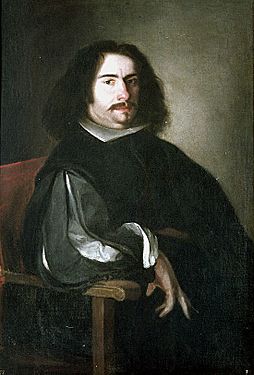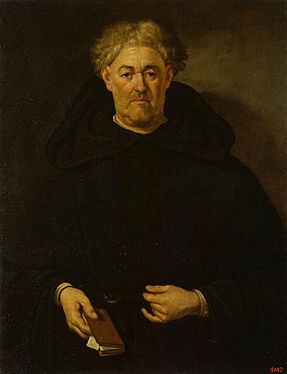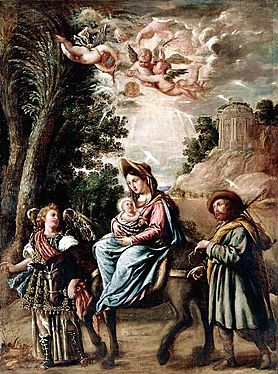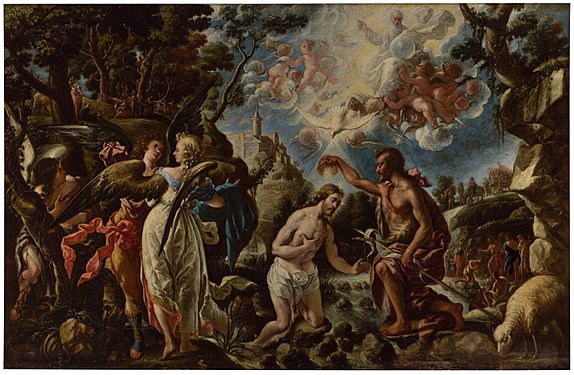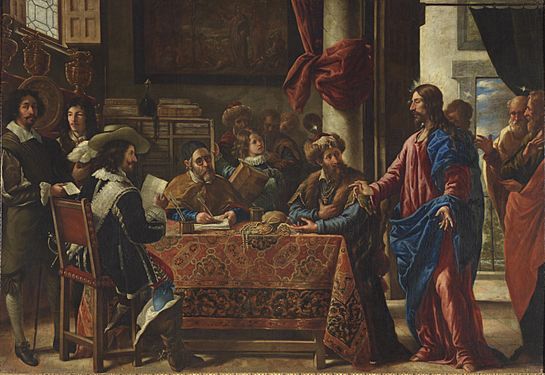Juan de Pareja facts for kids
Quick facts for kids
Juan de Pareja
|
|
|---|---|
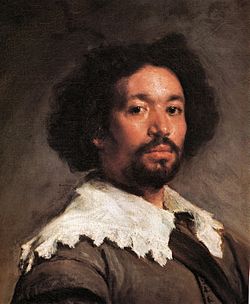
Detail of Velázquez's Portrait of Juan de Pareja
|
|
| Born | 1606 |
| Died | 1670 (aged 63–64) |
| Education | Diego Velázquez |
| Known for | Painting |
| Movement | Baroque |
Juan de Pareja (born around 1606 in Antequera, Spain – died 1670 in Madrid, Spain) was a Spanish painter. He is well-known for being part of the home and art studio of the famous painter Diego Velázquez. Juan de Pareja was born into slavery and later became a free man in 1650. One of his most famous paintings, The Calling of Saint Matthew (from 1661), can be seen at the Museo del Prado in Madrid.
Contents
About Juan de Pareja
Juan de Pareja was born in southern Spain, likely in Antequera in the Malaga province, around 1606. He was born into slavery. Not much is known about his early life. Some historical accounts describe him as being "of mixed background and unusual color."
Early Life and Freedom
The first time Juan de Pareja is mentioned as a painter is in a letter from 1630. In this letter, he asked for permission to move to Madrid to continue his art studies with his brother. However, some people question if this document is real because it says he was already a free man and does not mention Velázquez.
It is not clear when Juan de Pareja started working for Diego Velázquez. We know he was a witness for Velázquez in legal papers in 1642. He also signed documents for Velázquez and his wife in 1647. Later, in 1653, he signed a similar paper for Velázquez's daughter.
Journey to Italy
In 1649, Juan de Pareja traveled to Italy with Velázquez. While they were there, Velázquez painted his famous "Portrait of Juan de Pareja." This painting is now in the Metropolitan Museum of Art in New York. The portrait was shown in Rome in 1650 during a special event.
On November 23, 1650, while still in Rome, Velázquez gave Juan de Pareja a letter of freedom. This meant Juan would become free after four years, as long as he did not run away or commit any crimes. This important document, which gave him his freedom, is kept in Rome.
Becoming a Free Artist
After gaining his freedom, Juan de Pareja worked as an independent painter until he died in Madrid. He used the skills he learned in Velázquez's studio. He also showed knowledge of other Spanish and Italian painters. This suggests he had many important roles in Velázquez's workshop.
Juan de Pareja in Stories
- In 1965, Elizabeth Borton de Treviño wrote a book called I, Juan de Pareja. It is a fictional story about the lives of both Juan de Pareja and Velázquez.
Famous Artworks
Here are some of Juan de Pareja's notable paintings:
- Portrait of Agustín Moreto (1648–53), oil on canvas, Lazaro Galdiano Foundation, Madrid, Spain
- Portrait of a Monk (1651), oil on canvas, Hermitage Museum, Saint Petersburg, Russia
- The Flight into Egypt (1658), John and Mable Ringling Museum of Art, Sarasota, Florida
- The Calling of Saint Matthew (also known as The Vocation of Saint Matthew) (1661), oil on canvas, Museo del Prado, Madrid, Spain
- Saints John the Evangelist and Orontius, Augustine Collection, Madrid, Spain
- The Lady of Guadalupe, Augustine Collection, Madrid, Spain
- Portrait of the Architect José Ratés Dalmau, oil on canvas, Museu de Belles Arts de València, Spain
- Portrait of Philip IV, King of Spain (c.1656), oil on canvas, Columbia Museum of Art, United States
- El bautismo de Cristo (1667), Museo de Huesca/Museo del Prado, Huesca, Spain
Paintings of Juan de Pareja
Juan de Pareja was also painted by other artists:
- Portrait of Juan de Pareja (1648), by Diego Vélazquez, Metropolitan Museum of Art, United States
- Portrait of Juan de Pareja Repairing a Mandolin String (1960), by Salvador Dalí, Minneapolis Institute of Arts, United States
- Juan de Pareja painted himself as the leftmost figure in his own work, The Calling of Saint Matthew (1661), oil on canvas, Museo del Prado, Madrid, Spain
Gallery
-
Portrait of Agustín Moreto, (c.1648-53)
See also
 In Spanish: Juan de Pareja (pintor) para niños
In Spanish: Juan de Pareja (pintor) para niños
- Representation of slavery in European art
- List of slaves


